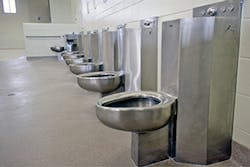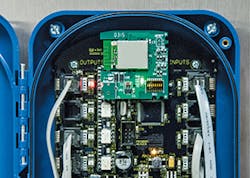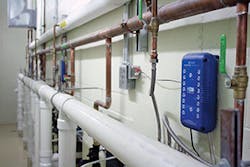The average cost of confinement across the country is approaching $30,000 a year for each prisoner, says Tommy Norris, who operates www.greenprisons.org. The most recent US Department of Justice prison population count places it at 2.1 million.
“That makes prison an extremely expensive operation for the taxpayer short-term and long-term, and virtually everything you have in a small city you have in a prison—from the food service to the laundry to the fire department—and nearly all of those functionsconsume utilities, including water,” notes Norris.
While one may assume that an inmate wouldn’t have cause to use any more water than the person who is not incarcerated, statistics reveal otherwise: the average person uses between 80–100 gallons of water per day and prisoners use 120–149 gallons per day. The reason: because they can.
In a prison, there is little that an inmate can control, points out Shawn Bush, president and CEO of I-CON Systems, which manufactures technology Norris regards as the “gold standard” in prison water efficiency.
“They are told when to eat, where to go, when to sleep, and when the lights can go on and off, but they can always control their button on their toilet,” says Bush.
“We have people locked up in prison for making some bad decisions, and just because they’re locked up doesn’t mean they stop making bad decisions,” notes Norris. “Historically, one of the things they’ve been able to control in those cells that have plumbing fixtures is the water. They jam stuff down the toilets, flood the toilets, and flood the range, creating dangerous situations of water overflowing off of the fourth or fifth tier. They want to mess with the staff. They want to demonstrate their angst.”
Inmates may or may not have trash cans, but nonetheless they’ll take food waste or other items and use the toilet as a trash can because they don’t want to have to smell it or deal with it, adds Bush.
“If inmates want to get out of their cell, they’ll clog their toilet and flush it multiple times and they’ll flood their cell to try to get out of their cell,” says Bush. “It’s one way they get to go into the recreational area or move somewhere while someone has to clean their cell out.”
Inmates also will use toilets to flush contraband away during a search.
In addition to water waste, excess flushing also leads to rapid wear and tear on the fixtures and increased maintenance and replacement costs.
There is a growing awareness among correctional facility administrators that is dovetailing with society in general about how valuable a commodity water is and how important it is to control, says Norris.
Six years ago, the American Correctional Association began to take a serious look at the importance of sustainability in the operation of correctional facilities, says Norris. He then started www.greenprisons.org, a nonprofit organization providing training, technical assistance, and information on sustainable practices and products for the correctional community.
Norris is a veteran prison administrator whose career spans work with the Federal Bureau of Prisons, the National Institute of Corrections, various state correctional systems, undergraduate instruction, and chairman of the American Correctional Association’s Clean and Green committee.
Norris considers three factors in correctional facility initiatives. One is that it has to make financial sense. “Ideally, it has to generate money but at the very least, it has to save significant dollars to make it worthwhile,” he says.
His second consideration: whether it will provide opportunities for offenders to learn new skills through training programs that will lead to job opportunities when they are released from prison.
Environmental impact is a third consideration. “The facility administrator is part of a community and has a vested interest in being seen positively by the community,” says Norris. “So when they speak with various community groups, they can talk about the tons of solid waste they’ve diverted from the landfill or their water conservation efforts.”
Depending on the facility’s location, water can rival energy in utility costs, points out Norris. In his home state of Kentucky, electricity is inexpensive compared to water, “which can get pretty pricey,” he adds.
“Add on the wastewater charges that typically are a factor of four on the back end of that,” says Norris. “Administrators are becoming more aware of water conservation in terms of the amount of water they use.”
Sustainability in prisons “checks a lot of the boxes that relate to revenue and financial solvency,” points out Norris. “Nobody is giving us any extra money to run these facilities, many of which are 40 to 100 or more years old and some of the plumbing in them seems like it’s almost that old. Looking for strategies to operate more efficiently is always important.”
Norris works with companies such as I-CON Systems and EasyWater, which uses salt-free water conditioning to help extend equipment life.
I-CON Systems, Inc. in Oviedo, FL, was founded in 1994 by a core group of individuals previously employed at a small local corporation which developed and manufactured plumbing systems using infrared technology for local major theme parks and Orlando area customers.
Company managers focused on targeting the untouched retrofit market of older jails and prisons by developing technology that would help in saving costs on water, maintenance, and repair.
“Local people in the correctional industry started telling me about their problems with water because I was doing water control with the commercial side,” notes Bush. “I thought if one facility was having these kinds of problems, a lot of facilities had it.”
I-CON Systems provides vandal-resistant systems that remove an inmate’s ability to abuse the plumbing systems. The systems are designed to conserve water, conserve costs, and increase security.
Products offered include valves for flush, lavoratory, shower, and urinals for new installations and retrofits. The company offers non-communicating and communicating controls and a computer system network operation for main control of pods and units by touchscreen technology allowing a correctional officer to control a single cell or entire pod in seconds for security purposes and monitor water consumption in real time. It is a 24-volt system. Battery operated units are available. The company offers a stainless steel series of fixtures.
I-CON Systems installs a small controller akin to a microprocessor in the chase area behind the cell where the inmates can’t get to it. The controller tracks how often someone is flushing the toilet. The technology is used to control how often the toilet can be flushed through the flush valve. The microprocessor locks the system out for a specified amount of time for an inmate or particular group of inmates.
I-CON’s flush valve is designed to use half of the water of other flush valves, says Bush.
“Normally, we’ll flush 3.5 gallons or 1.6 gallons every flush,” he says. “The I-CON technology flushes 1.6 gallons on 3.5-gallon toilets in prisons or can flush 1 gallon on a 1.6-gallon fixture. So every time an inmate flushes, the technology controls how often they flush and flushes half the amount of water. Those two factors will get about a 70% savings based on not having this technology installed.”
The microprocessor can act like a control on a standalone basis. The microprocessors and controllers can be looped together. “The touch screen would be able to see the entire facility or the pod and then correctional officers can control each one of those cells as individuals or as a group,” says Bush.
“If the correctional officers were going to do a search because they thought there was contraband in there, they could push one button on a touch screen. All of the toilets could go on a lock-out mode where somebody can’t flush the toilet and then they could do their search so the contraband can’t be flushed away,” he adds.
When doing a search application, the screen enables the user to see while an inmate is pushing the button as they throw contraband in the toilet that the action is taking place in a particular cell.
Systems like I-CON allow the correctional staff to regulate an inmate’s access to water and thus quash their ability to flush items down the toilet that are not meant to be flushed, says Norris. It takes the control of water out of the hands of prisoners and puts it squarely with correctional staff members.
I-CON’s water monitoring technology helps control prison water use in a way that is inconspicuous to prison inmates.
“If they misuse it, you can cut it off. With the I-CON System, if there are one or two bad actors who are trying to flood their cell, you simply reduce their access to water to two flushes an hour and 30 seconds of washing for hands time and that’s it. The rest of the guys on the range who are acting responsibly can still have access to it as they need it, but it eliminates the ability for an offender to act out by using water as a weapon,” says Norris.
The system is designed in such a fashion that the officer on the range who is not a plumber or otherwise technically skilled can control it from his or her desk at such hours as 3 a.m. without having to call a maintenance foreman in, says Norris, adding that it saves on costs.
The touch screen is designed to be user-friendly, says Bush. It features a graphical layout of the facility’s floor plan. A menu allows the user to pull up a picture of a particular cell and offers the option of putting it on a lockdown mode—flushing it, doing maintenance, or troubleshooting it.
Prison staff is trained in its use. I-CON Systems provides training each quarter or will send trainers to the site if there are a number of people needing training, says Bush.
While the technology is often installed by outside contractors, maintaining it is often done by the inmates, says Bush.
“Not only is the maintenance staff there when we do a training, but more often than not, the inmate trustees are there as well, because they are the ones out there in the trenches helping to troubleshoot something or report back to the maintenance managers what they’re seeing and are replacing and maintaining those parts.”
The I-CON Systems technology offers a two- to five-year payback.
“This kind of technology is not everywhere in corrections, but it is certainly growing,” says Norris. “Institutions where I know it has been installed swear by it. They appreciate the savings, but beyond that, it’s one more level of control they’ve got to make the institution safer for the staff and for the inmates.”
Another sustainability measure has had unintended consequences of water waste.
Before any effluent goes out into the sewage treatment system—be it operated by the facility or a municipality—it is ground up in sewage grinders that make it more biodegradable and thus keep it out of the landfill, saving landfill space and hauling expenses. Norris points out that each inmate produces between 1 and 1.5 pounds of solid food waste a day.
While Norris says there’s a value in the food waste not going to the landfill, he adds that the processing of grinding up the waste that goes into the wastewater treatment system utilizes a great deal of water.
“So it’s ‘green’, but the realities are the water bills they’re running up is almost counterproductive, so correctional systems are looking at either traditional composting, windrow composting, or in-vessel composters that will dispose of all of the solid food waste without using any water,” he says.
Norris says some prison systems are more aware of the need for water conservation than others.
“When you have a physical plant that’s 80 to 100 years old and you’ve got boilers that have been patched and retrofitted and steam lines that have been underground for 80 years and leak like sieves, it can be very difficult to get money from legislators for correctional projects of any kind, but particularly for those,” says Norris. “The thinking is it’s only another 10% on the water bill. We’ll just let that slide and do something else. The cost of maintaining these old structures and converting the infrastructure to more modern energy- and resource-saving strategies can be very challenging.”
Many correctional systems are working diligently to have an impact on water conservation, says Norris.
I-CON Systems’ technology is now in more than 400 correctional facilities in the US, Canada, and some locations outside of North America. One installation is at FCI Coleman Low, the country’s largest federal facility, which is located in Florida.
Norris offers as a case in point the Indiana Department of Correction’s facility retrofits. “They are looking at all of the factors surrounding water costs because it is growing exponentially for them and their maintenance director is very proactive in trying to find ways that will impact the cost of his operations.”
The Marion County Detention Center, a 300-bed jail in south central Kentucky, recently audited its entire operation as it approached 25 years. Much of the infrastructure was starting to break down, including a new boiler that was “leaking like a sieve,” notes Norris.
“When the consultant finished looking at the snapshot of the facility, unlike most facilities where energy is a big ticket item, in fact, it was water,” says Norris. The facility switched to a tankless water heater and is now saving more than 30% on the water bill now, which produces similar savings on the wastewater bill, he adds.
I-CON Nexus Controller
In states where water conservation is on a crisis level and even farmers growing food are making water sacrifices, such as California, cognizance of the importance of the prison sector is more pronounced.
“A lot of systems, particularly those in California, have gone away from watering gardens,” he says. “They’ve become very creative in the use of repurposing water in a lot of ways. The unfortunate part is they haven’t had much rain to repurpose.”
California is building a lot of new prisons and is incorporating state-of-the-art water-saving technologies in them, says Norris.
In addition to I-CON Systems’ technology, other water saving measures are being touted for the prison system, though not widely adopted as of yet. As stated in the Greening
Corrections Technology Guidebook, prepared for the National Law Enforcement and Corrections Technology Center, waterless urinals is one option.
Case in point: Florida’s 900-bed Alachua County Jail’s water conservation program included the replacement of existing 3.5-gallons-per-flush (gpf) pneumatically controlled toilets with new controlled 1.6-gpf toilets containing security lock-out controls, the installation of waterless urinals, and the replacement of lavatory and shower controls and valves throughout the facility with tamper-resistant, automatic-shutoff timer controls. The jail achieves an overall 62% reduction in water use from 36 million gallons per year to approximately 17 million gallons per year.
Rainwater catchment is another option. E. W. Bob Boulware, P.E., president of Design-Aire Engineering in Indianapolis, IN, points out three reasons to utilize rainwater harvesting.
“One is that you don’t have enough water and there’s too long of a period between rainfalls, so it acts as a bank account for water,” he says.
The second is poor water quality, which is getting to be a bigger issue, he adds.
The third is stormwater management. He cites downtown New York City, which collects the first inch of rain on site, as an example of how it’s done. “They’ll reserve a part of their rainwater collection tank for that first inch of rain and then there’s a metered opening that drips that water someplace—typically watering landscape or metering it into the storm system to reduce that first influx of water that the storm will impart on the sewage system,” he says.
“It reduces combined sewer overflows when a storm comes in, overflows the sewage treatment plant and then all of a sudden sewage is going down rivers and streams, making it a polluted water source. Downstream somebody is going to be trying to get water out for their city water.”
Rainwater catchment is effective in areas where drought and water shortages are common, points out Boulware.
A stormwater pipe system can be undersized after paving a large area, says Boulware. Measures that can be taken include controlling the site grade to water area vegetation, create pervious parking areas and utilize underground cisterns for later water use. LEED points can be acquired through such practices.
Correctional facilities not only can be proving grounds for new water conservation technologies, but in many ways, they are a microcosm of what it takes to run a city and as part of a community. “It’s really important for a lot of reasons—not the least of which is efficiency—that they be run responsibly,” says Norris.
Correctional facility management can provide teaching moments to the community at large, he adds.
“You might have some sort of calamity where maybe a water main gets ruptured,” says Norris. “You’ve got 2,000 guys and you can’t let them sit in their cells and dehydrate and not be able to go to the bathroom, so it creates all of these social and security issues about trucking in bottled water and bringing in porta-potties, all of which can be very challenging as corrections finds ways to deal with emergencies,” says Norris.
As such, those lessons are exportable to other sectors in society, he adds.
Although prisons are the target market, Bush points out that the I-CON System technology can be converted to other industrial and commercial settings to track and analyze data within a facility, as well as troubleshoot problems.
I-CON System’s Ed Hull, customer service manager, points out that many states are interested in conserving water—some of them more critically than others because of drought situations.
“Even if you’re not facing that kind of situation, you need to be preparing for the future and start conserving the water now,” he says.


